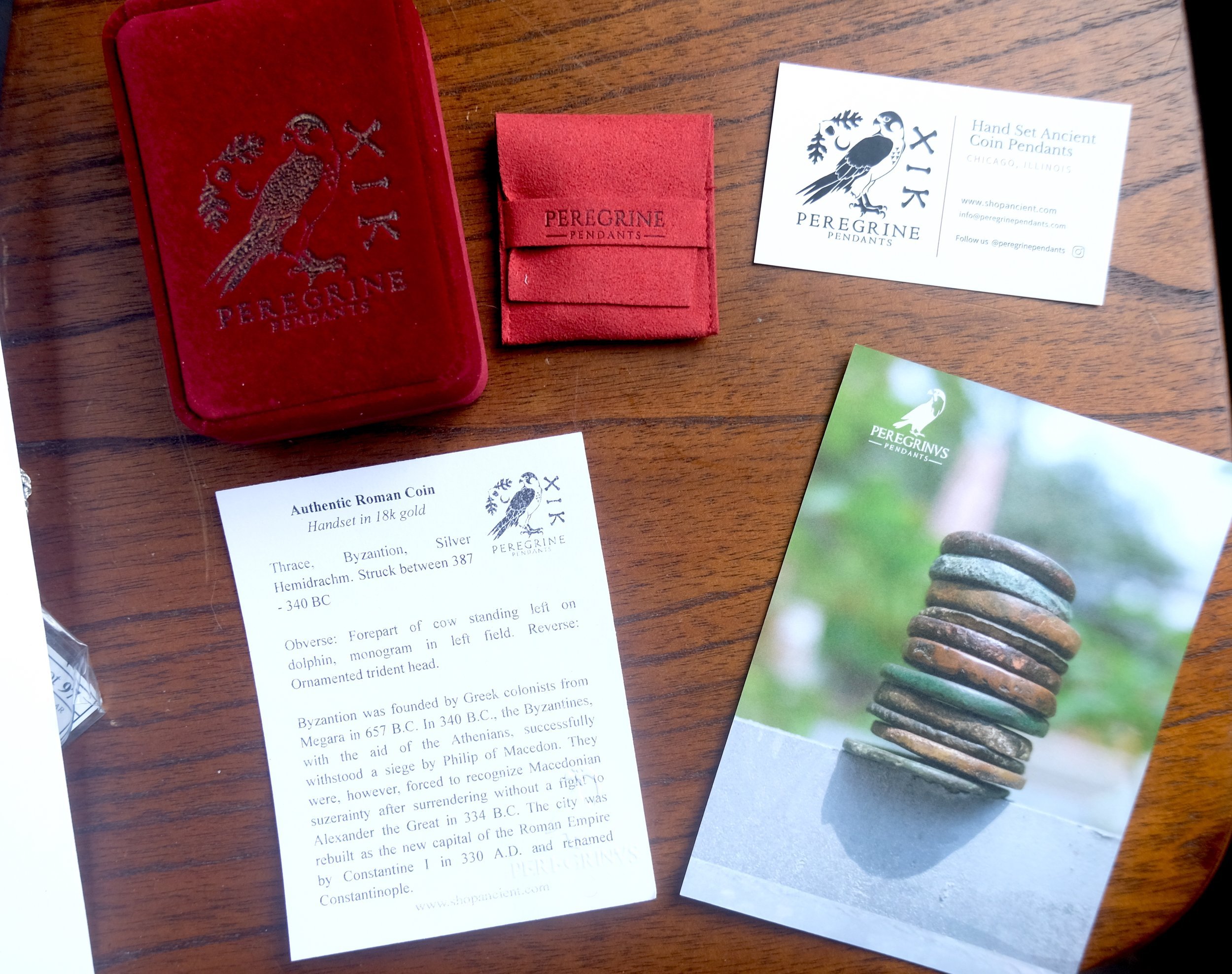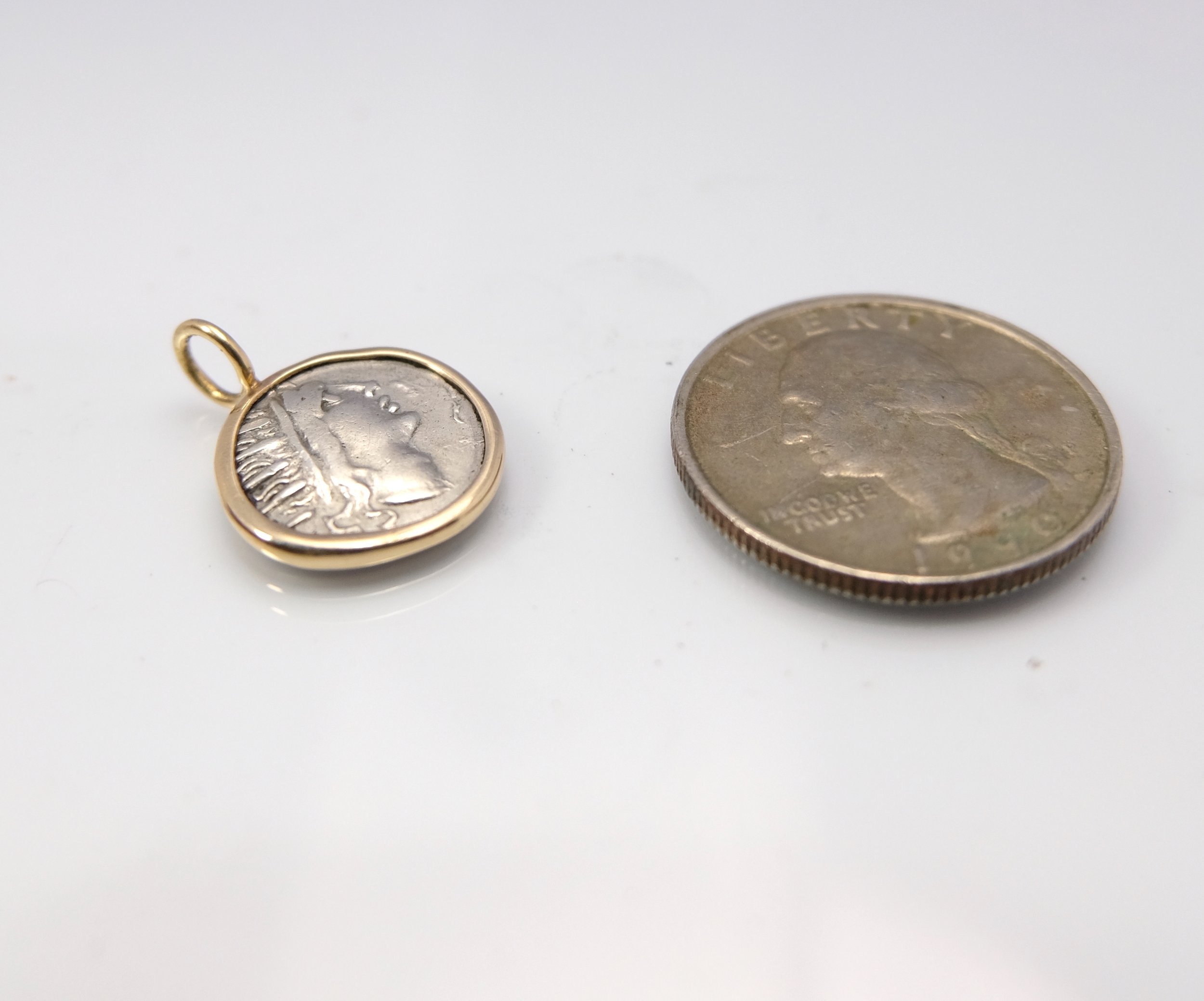 Image 1 of 5
Image 1 of 5

 Image 2 of 5
Image 2 of 5

 Image 3 of 5
Image 3 of 5

 Image 4 of 5
Image 4 of 5

 Image 5 of 5
Image 5 of 5






Phoenician coin with Bee & Stag - Circa 155 BC - Island of Arwad
To appreciate its size (17 mm), the relief of the coin and the shape of the bail, see the picture showing the coin next to a US Dime. The coin was set in a gold prong setting. This was then sanded and polished. This pendant is built to last.
The coin measures about 17 mm diameter and weighs 3.6 grams (see picture with a US quarter for scale).
PHOENICIA, Arados. Silver Drachm
Obverse: bee; Θ(koppa) (date) to upper left, monogram to upper right
Reverse: stag standing right; palm tree in background
Dated CY 99 (161/0 BC)
The island was settled in the early 2nd millennium BC by the Phoenicians. Located some 50 kilometres (31 mi) north of Tripolis, it was a barren rock covered with fortifications and houses several stories in height. The island was about 800 m long by 500 m wide, surrounded by a massive wall, and an artificial harbor was constructed on the east toward the mainland. It developed into a trading city in early times, as did most of the Phoenician cities on this coast. It had a powerful navy, and its ships are mentioned in the monuments of Egypt and Assyria. In the Bible, an "Arvad" is noted as the forefather of the "Arvadites", a Canaanite people. The Phoenicians collected rain water in cisterns and shipped fresh water to the island, eventually discovering an undersea freshwater spring nearby.
The city of Arwad seems to have had a sort of hegemony over the northern Phoenician cities, from the mouth of the Orontes to the northern limits of Lebanon, something like that of Sidon in the south. It brought under its authority some of the neighboring cities on the mainland, such as Marat (present-day Amrit) and Sumur, the former nearly opposite the island and the latter some kilometers to the south. It had its own local dynasty and coinage, and some of the names of its kings have been recovered.
To appreciate its size (17 mm), the relief of the coin and the shape of the bail, see the picture showing the coin next to a US Dime. The coin was set in a gold prong setting. This was then sanded and polished. This pendant is built to last.
The coin measures about 17 mm diameter and weighs 3.6 grams (see picture with a US quarter for scale).
PHOENICIA, Arados. Silver Drachm
Obverse: bee; Θ(koppa) (date) to upper left, monogram to upper right
Reverse: stag standing right; palm tree in background
Dated CY 99 (161/0 BC)
The island was settled in the early 2nd millennium BC by the Phoenicians. Located some 50 kilometres (31 mi) north of Tripolis, it was a barren rock covered with fortifications and houses several stories in height. The island was about 800 m long by 500 m wide, surrounded by a massive wall, and an artificial harbor was constructed on the east toward the mainland. It developed into a trading city in early times, as did most of the Phoenician cities on this coast. It had a powerful navy, and its ships are mentioned in the monuments of Egypt and Assyria. In the Bible, an "Arvad" is noted as the forefather of the "Arvadites", a Canaanite people. The Phoenicians collected rain water in cisterns and shipped fresh water to the island, eventually discovering an undersea freshwater spring nearby.
The city of Arwad seems to have had a sort of hegemony over the northern Phoenician cities, from the mouth of the Orontes to the northern limits of Lebanon, something like that of Sidon in the south. It brought under its authority some of the neighboring cities on the mainland, such as Marat (present-day Amrit) and Sumur, the former nearly opposite the island and the latter some kilometers to the south. It had its own local dynasty and coinage, and some of the names of its kings have been recovered.
To appreciate its size (17 mm), the relief of the coin and the shape of the bail, see the picture showing the coin next to a US Dime. The coin was set in a gold prong setting. This was then sanded and polished. This pendant is built to last.
The coin measures about 17 mm diameter and weighs 3.6 grams (see picture with a US quarter for scale).
PHOENICIA, Arados. Silver Drachm
Obverse: bee; Θ(koppa) (date) to upper left, monogram to upper right
Reverse: stag standing right; palm tree in background
Dated CY 99 (161/0 BC)
The island was settled in the early 2nd millennium BC by the Phoenicians. Located some 50 kilometres (31 mi) north of Tripolis, it was a barren rock covered with fortifications and houses several stories in height. The island was about 800 m long by 500 m wide, surrounded by a massive wall, and an artificial harbor was constructed on the east toward the mainland. It developed into a trading city in early times, as did most of the Phoenician cities on this coast. It had a powerful navy, and its ships are mentioned in the monuments of Egypt and Assyria. In the Bible, an "Arvad" is noted as the forefather of the "Arvadites", a Canaanite people. The Phoenicians collected rain water in cisterns and shipped fresh water to the island, eventually discovering an undersea freshwater spring nearby.
The city of Arwad seems to have had a sort of hegemony over the northern Phoenician cities, from the mouth of the Orontes to the northern limits of Lebanon, something like that of Sidon in the south. It brought under its authority some of the neighboring cities on the mainland, such as Marat (present-day Amrit) and Sumur, the former nearly opposite the island and the latter some kilometers to the south. It had its own local dynasty and coinage, and some of the names of its kings have been recovered.
You Might Also Like


























